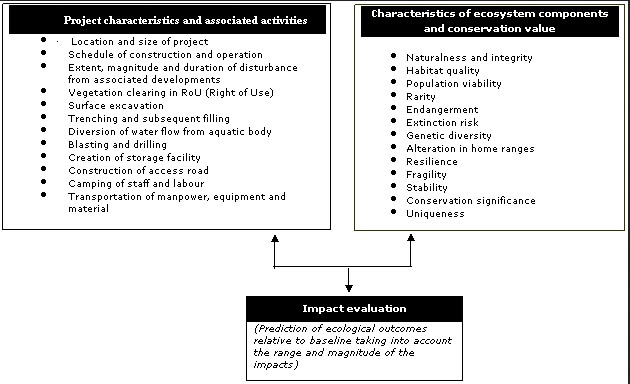Impact Prediction
|
Impact evaluation phase of EIA is essentially an exercise to anticipate changes in the environmental baseline, predict secondary and synergistic consequences of anticipated changes on the physical, natural & social components of the environment and evaluate the significance of predicted impacts for the purpose of guiding the decision making process. 4.1 Predictive Approach Fig. 7 Key characteristics of the project and the ecosystem components considered in impact assessment
The conservation significance of these ecosystems was determined using the criteria defined by Ratcliffe 1977; Margules & Usher 1981. Table 4.1 & 4.2 provide the assessment of conservation values of the valued terrestrial and aquatic systems en route the proposed pipeline. Table 4.1 Conservation values of terrestrial habitats en route the proposed pipeline Table 4.2 Conservation values of aquatic habitats en route the proposed pipeline 4.2 Basic Assumptions Drawn for Impact Prediction The following assumptions were significant in drawing the conclusions from the ecological assessment. i. The disturbance resulting from the project actions during construction phase would be uniform all along the pipeline length. ii. Conservation values and habitat features determine the seriousness of predicted impacts on wildlife values. iii. The feasibility of mitigation strategies would be determined by the seriousness of impacts and the available alternatives. iv. Community concerns associated with the rehabilitation and land acquisition in this pipeline extension project are being addressed in the integrated environmental impact assessment report. v. With the implementation of pipeline operation through computer controlled Supervisory Control and Data Acquisition (SCADA) system supported by the state of art telecommunication system, the probability of accidents during transportation of projects is negligible. Despite this, the hazards associated with leakage and pilferage of products and damage of pipeline due to natural calamities such as floods and earthquakes are essential aspects that need to be given due consideration. The WII report does not address these aspects and presumes that these considerations have been incorporated in the project design and have been also addressed in the disaster management plan prepared for the implementation of this project. 4.3 Key Conclusions 1. The proposed pipeline will traverse a length of 28.6 km. of forest in as many as 25 fragments in the entire 357 km stretch of pipeline corridor through the states of Maharashtra (17.1 km) and Madhya Pradesh (11.50 km). 2. The Reserved Forest patches and the plantation areas en route the pipeline are depleted in wildlife status owing to pressures of livestock grazing, wood removal, lopping and land encroachment for agriculture and settlements. The proposed project is therefore not likely to bring about significant changes in the wildlife status of these habitats. 3. The proposed pipeline will also traverse several rivers in the proposed pipeline corridor. Most of these rivers are seasonal and have been heavily impacted by biotic activities. The conservation significance of aquatic values of most rivers en route are fairly low and therefore do not pose major challenges to pipeline laying. 4. The impacts of proposed pipeline are likely to be significant on Narmada river owing to presence of large number of species of high conservation. Laying the pipeline across this river would need careful planning. 5. The impact on Segwal pond on account of its high conservation status is also considerable. |
Last Updated: October 7, 2015










